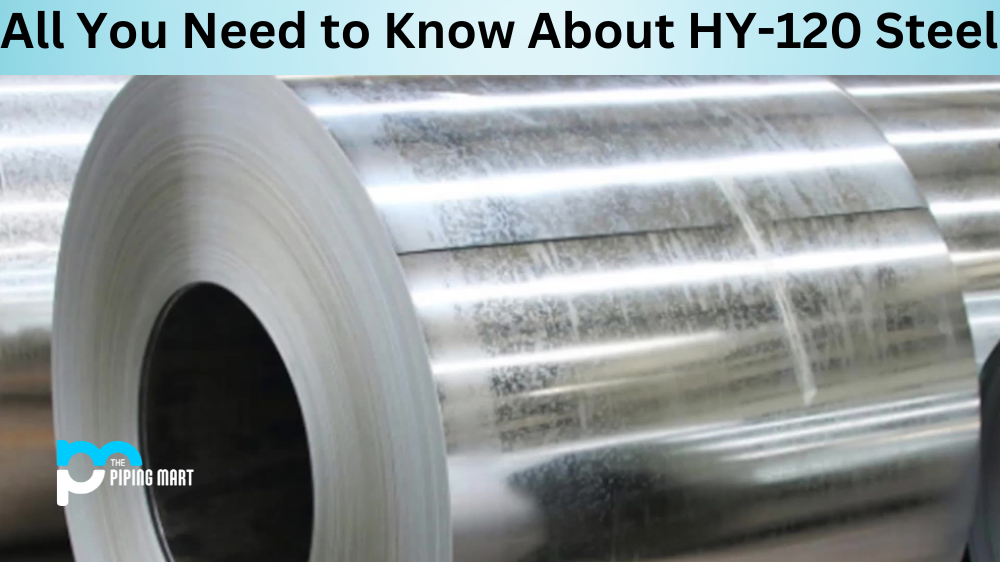Steel is one of the most versatile materials, revolutionizing the modern construction industry. Various steel grades create strong, durable, and reliable structures and products. HY-120 is commonly used in the naval, offshore, and marine industries. But what exactly is HY-120 steel, and what makes it special? This blog post will explore all you need to know about HY-120 steel, including its composition, physical and mechanical properties, uses, hardness, and heat treatment.
HY-120 Steel Composition
HY-120 is a high-strength, low-alloy (HSLA) steel designed for use in the naval, offshore, and marine industries. It contains a low carbon content of approximately 0.07%, and its primary alloying elements are silicon, manganese, nickel, chromium, and molybdenum. The Manganese content is between 1.8 and 2.2%, nickel between 2.9 and 3.5%, chromium between 0.9 and 1.2%, and molybdenum approximately 0.1%. All these elements work together to give HY-120 its unique properties.
| Element | Content (%) |
|---|---|
| Iron, Fe | 92.8 – 96.2 |
| Nickel, Ni | 2.25 – 3.50 |
| Chromium, Cr | 1.0-1.80 |
| Copper, Cu | ~ 0.25 |
| Molybdenum, Mo | 0.20 – 0.60 |
| Silicon, Si | 0.15 – 0.35 |
| Carbon, C | 0.12 – 0.20 |
| Manganese, Mn | 0.10 – 0.40 |
| Vanadium, V | ~ 0.030 |
| Phosphorous, P | ~ 0.025 |
| Sulfur, S | ~ 0.025 |
| Titanium, Ti | ~ 0.020 |
HY-120 Steel Physical Properties
HY-120 steel has excellent physical properties that suit harsh and demanding environments. Its density is 7.85 g/cm3, and its thermal expansion coefficient is between 11.7 and 12.6 µm/m.°C. Its thermal conductivity is 35-40 W/m. °C, and its electrical resistivity is approximately 1.67 x 10^-7 Ω.m. These properties make HY-120 steel ideal for heat exchangers, pressure vessels, and other industrial applications.
| Properties | Metric | Imperial |
|---|---|---|
| Density | 7.85 g/cm3 | 0.284 lb/in3 |
HY-120 Steel Mechanical Properties
HY-120 steel has exceptional mechanical properties that make it stand out. It has a minimum yield strength of 827 MPa, a minimum ultimate tensile strength of 931 MPa, and an elongation at a break of 12%. This steel is also corrosion-resistant and has excellent resistance to hydrogen embrittlement. These mechanical properties make HY-120 steel suitable for naval ships, submarines, and offshore structures.
| Properties | Metric | Imperial |
|---|---|---|
| Yield strength | 689 MPa | 100000 psi |
| Shear modulus (typical of steel) | 80 GPa | 11600 ksi |
| Elastic modulus (typical of steel) | 205 GPa | 29700 ksi |
| Poisson’s ratio | 0.28 | 0.28 |
HY-120 Steel Uses
HY-120 is high-strength steel commonly used in the naval, offshore, and marine industries. It fabricates shells, pressure vessels, submarines, and hulls for ships. It is also used to construct oil rigs, platforms, and pipelines in harsh environments. Additionally, HY-120 steel is used to produce armoured vehicles, military aircraft, and missile systems.
HY-120 Steel Hardness
HY-120 steel has a hardness range of 311 to 352 HB. This is due to alloying elements such as manganese, nickel, chromium, and molybdenum. The high hardness makes HY-120 steel resistant to wear and tear, which is essential for applications requiring high abrasion resistance.
HY-120 Steel Heat Treatment
HY-120 steel can be heat-treated to enhance its strength and other properties. Heat treatment involves heating the steel to a specific temperature and cooling it rapidly or at a controlled rate. The heat treatment process can increase the hardness, tensile strength, and toughness of HY-120 steel. This makes it an ideal material for marine and naval applications, where strength is vital.
Conclusion
HY-120 is high-strength, low-alloy steel widely used in the naval, offshore, and marine industries. Its composition, physical and mechanical properties, and heat treatment make it ideal for high-strength and tough applications. Its unique properties, such as corrosion resistance and hydrogen embrittlement resistance, make it ideal for use in harsh and demanding environments. HY-120 steel is a testament to the versatility and adaptability of steel, and it continues to transform the construction and manufacturing industry worldwide.
Meet Heer, a dynamic and driven writer learning tricks of her trade in the metal industry. With a background in Digital Marketing, Heer brings a unique perspective to her writing, sharing valuable insights. Apart from blogging she like reading and hiking.




